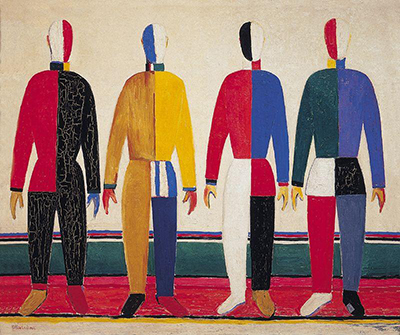Sportsmen, or Спотрсмены to use its original Russian title, was produced by Kazimir Malevich in 1931, at a time when he had been forced to alter his style by the ruling powers of that period.
His work of two decades earlier had virtually left reality behind but by now he had reverted back to modern depictions of real things, which in this case were sportsmen from the early 20th century. He would do the same with peasants as well, and it became very fashionable within Russia to focus on the lives of ordinary working class folk. In previous centuries, particularly in western Europe, most artists had in fact concentrated on the rich and famous, often because they were the only ones with the funds to offer financial support. Russia was going through an important time where normal people wanted power and influence, collectively, and art would start to reflect this. Unfortunately, not all artists took this new direction out of choice but was forced to do so or face the wrath of the state which was now starting to dictate its own values and demand that artist's oeuvres better reflect them.
Sportsmen is now believed to reside within the State Russian Museum in St. Petersburg although very little detail on it has yet been translated into English. The interesting aspect to note about this particular artwork is that the variation in colours between the different figures is entirely planned and with a reason behind it. The tones are to represent different sports, and also to convey the emotions around each one, so essentially we see before us here four sportsmen from different disciplines standing together. Other than this variation, everything else is entirely uniform, from the identical postures, to the style of the clothing and even the background which sweeps horizontally across behind them. Malevich appeared to have found an approach which would not fall foul of conservative rulers, but at the same time at least give him some enjoyment whilst working under this regime.
Sadly, the artist would only live for a few more years after this painting was completed. That said, he still did well to survive this long when you consider the fate of many of his siblings as well as the political upheaval which he was then to live through over several decades. More on his life can be found in this biography. Despite his problems in later life he was still able to influence Western Art in a huge way, and this is underlined by how many art galleries in Europe and the US which continue to promote his work and explain to new generations about the importance of his legacy in pushing art ever onwards. Even today exhibitions of his work are extremely common and typically well received by the public who still view his work as fresh and exciting, more than a century later.




